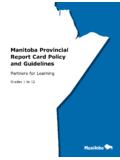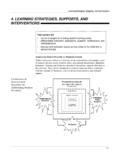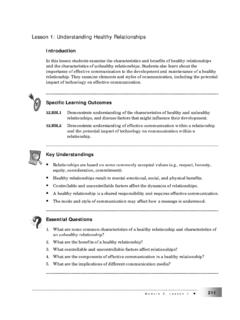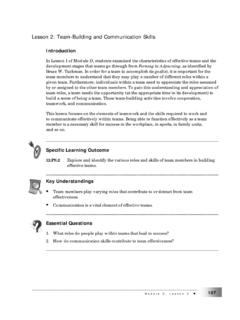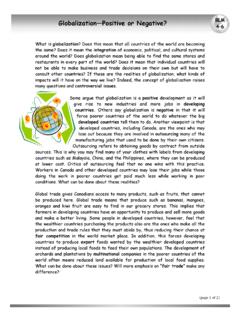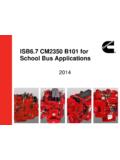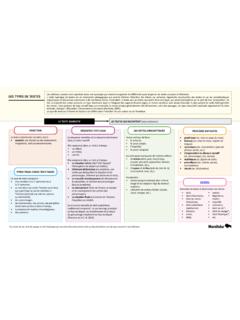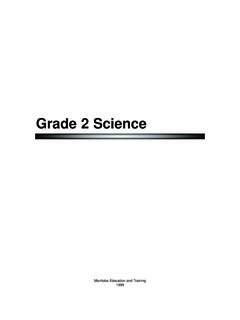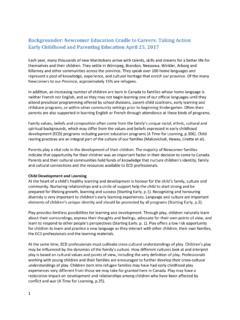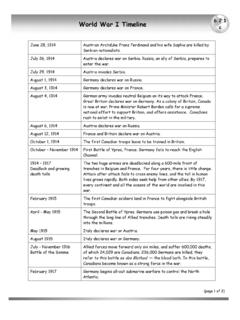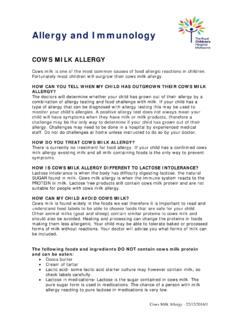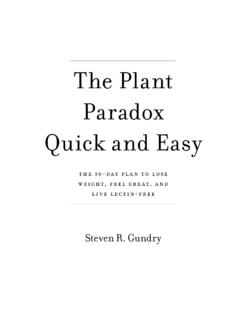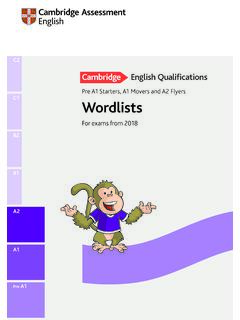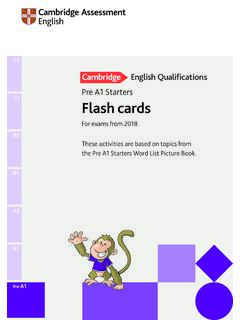Transcription of Grade 5 Science - Province of Manitoba
1 Manitoba Education and Training2000 Grade 5 ScienceGrade 5 Cluster 1:Maintaining a Healthy BodyOverviewThe study of the human body at Grade 5 focuses on themaintenance of good health. Students learn about the role thatnutrients play, and how to plan balanced and nutritious mealsusing Canada s Food Guide to Healthy Eating. Students gainexperience in interpreting nutritional information on food labels,and in evaluating images presented by the media. A study of themajor body systems and their role in the healthy functioning ofthe human body helps students to appreciate the nature andfunction of each, and the interrelationships that exist betweensystems. Students explore how lifestyle choices andenvironmental factors can affect personal 5 to 8 Science : A Foundation for Implementation FORINSTRUCTIONS tudents Introduce, explain, use, and reinforce vocabulary throughout thiscluster.
2 Sort and PredictProvide students with a set of words. Have them work in groupsto predict the meaning of the words and sort them intocategories. Have groups share their categories with the class. Asa class, identify words for which students need more informationto be able to categorize them with clarity. Post these words andclarify them as the study of the human body progresses.(For a BLM of a Sort and Predict think sheet, see SYSTH,Attachment , or Success, p. )5-1-01 Use appropriate vocabularyrelated to their investigations ofhuman : nutrients; carbohydrates;proteins; fats; vitamins; minerals;Canada s Food Guide to HealthyEating; food group; serving size;terms related to the digestive,skeletal, muscular, nervous,integumentary, respiratory, andcirculatory : B3, C6, D1 Teacher NotesPrior KnowledgeStudents have had previous experiences related to this cluster in Grade3, Cluster 2: Materials and Structures; in Grade 2, Cluster 1: Growthand Changes in Animals; in Grade 1, Cluster 1: Characteristics andNeeds of Living Things.
3 And in Grade 1, Cluster 2: The to Kindergarten to Senior 4 Physical Education/HealthEducation: Manitoba Curriculum Framework of Outcomes forActive Healthy Lifestylesfor related learning outcomes andteacher FORASSESSMENTG rade 5, Cluster 1: Maintaining a Healthy BodyGrades 5 to 8 Science : A Foundation for Implementation nutritionalinformation found on food : ingredient proportions,identification of potential allergens,information related to energy contentand : B3, C4, C5, C8 Investigating Food LabelsBring to class a variety of foodstuff boxes/cans that providenutritional information on the labels. Have students look at the information provided list the information that the labels have in common identify the differences that they see give reasons for the information providedExample:Nutrient Content Interpreting Nutritional InformationHave students bring to class a collection of foodstuff boxes/cansand sort them according to product ( , cereal, crackers).
4 Havesmall groups of students each take one set of boxes and orderthem in different ways. Examples: Order the boxes from the greatest to the smallest quantity ofcalories/energy per serving. Order the boxes from the lowest to the highest fibre content. Order the boxes from the lowest to the highest sugar Link:The boxes can also be used to determine perimeter,area, and volume. InformationCerealCrackersSoupProportion/ Serving SizeEnergy/CaloriesProteinFatCarbohydrat esSugarsStarchDietary FibreSodiumPotassiumVitamin ListIngredient ListSUGGESTIONS FORINSTRUCTIONS tudents information using a variety ofsources. Examples: libraries, magazines,community resource people, outdoorexperiences, videos, CD-ROMs, GLO: C6 (ELA Grade 5, ; Math: )5-0-4cWork cooperatively with group membersto carry out a plan, and troubleshoot problemsas they arise.
5 GLO: C7 (ELA Grade 5, )5-0-5fRecord and organize observations in avariety of ways. Examples: point-form notes,sentences, labelled diagrams, charts, orderedlists of data, frequency diagrams, GLO: C2, C6 (ELA Grade 5, ;Math: ) Response Provide students with the following:Food Product AnalysisNutrition Information Per 28 g ServingEnergy150 cal/620 gCholesterol0 mgCarbohydrates15 gDietary gSodium178 mgPotassium386 mgPercentage of Recommended Daily IntakeVitamin E23%Vitamin C15%Thiamine3%Riboflavin2%Niacin10%Vitam in B61%Calcium1%Iron3%Zinc3%Review the nutrition information above. What can you tellabout the product that it came from? Look for: low serving size high calorie and fat content high potassium content relatively high fibre content very few vitamins or mineralsPan Canadian Science Place 5: BodyWorks(Lesson 3)SUGGESTEDLEARNINGRESOURCESSUGGESTIONS FORASSESSMENTG rade 5, Cluster 1: Maintaining a Healthy BodyGrades 5 to 8 Science : A Foundation for Implementation the types of nutrientsin foods and their function inmaintaining a healthy : carbohydrates, proteins, fats,vitamins, : B3, D1 Nutrient ResearchUse the Jigsaw technique (Aronson et al, 1978) to have studentsresearch each of the five nutrients: carbohydrates, proteins, fats,vitamins, and minerals.
6 Divide the class into home groups offour members. Have each home group member select one of thenutrients to research. Individuals from each home group thenmeet with members of other home groups who are assigned thesame nutrient, to form expert groups. Each expert groupresearches its own nutrient to determine what it is, where it isfound, and what function it serves in maintaining a healthy , each group expert member shares findings with thehome group. (For strategies to aid students in recording information in theirown words and referencing sources, refer to 5-8 ELA, Grade 5,learning outcome , pp. 262-268.) Graphing Nutrient ContentGive each student one of the foodstuff boxes/cans that the classhas contributed. Have students graph the nutrient of having students put the name of the food on thegraph, have them put it on the back of the page.
7 Suggest thatstudents look at the graphs and predict which food is beingrepresented. SUGGESTIONS FORINSTRUCTIONS tudents information using a variety ofsources. Examples: libraries, magazines,community resource people, outdoorexperiences, videos, CD-ROMs, GLO: C6 (ELA Grade 5, ; Math: )5-0-2bReview information to determine itsusefulness, using predetermined criteria. GLO: C6, C85-0-2cRecord information in own words andreference sources appropriately. GLO: C6 (ELAG rade 5, )5-0-4dAssume various roles and shareresponsibilities as group members. GLO: C7(ELA Grade 5, )5-0-6aConstruct graphs to display data, andinterpret and evaluate these and other : bar graphs, frequency tallies, lineplots, broken line GLO: C2, C6 (ELAG rade 5, ; Math: , , ; TFS: )Teacher NotesBackground Information Carbohydratesare the body s main source of energy.
8 There are twotypes of carbohydrates: simple and complex. Simple carbohydratesare sugars. They are naturally found infoods such as milk and fruit. They are also added to foods suchas candy, cake, and ice cream. Complex carbohydratesare starches and cellulose. They arefound in foods such as potatoes, bread, vegetables, and rice. Proteinsare the building blocks needed for growth and maintenanceof the body. They are found in meat, dried beans, grains, andvegetables. Fatsare a high-calorie source of energy needed for growth andmaintaining healthy skin. They are found in meat, nuts, cheese,butter, margarine, oil, and milk. Vitamins and mineralsare important to the body for growth andnourishment. Milk products and raw vegetables and fruits aregood sources of these nutrients.
9 Food processing causes lossof vitamins and ResponseProvide students with the following:NutrientsIn your Science notebook, explain how each of the followingtypes of nutrients helps you maintain a healthy carbohydrates2. proteins3. fats4. vitamins5. mineralsExtended ResponseProvide students with the following:Diets: Healthy or Not Healthy?Many different diets are available for people who want tolose or gain weight. Explain why each of the following dietsis either healthy or not the Low or No Carbohydrate Diet2. the High Protein Diet3. the No Fat DietPan Canadian Science Place 5: BodyWorks (Lesson 2)SUGGESTEDLEARNINGRESOURCESSUGGESTIONS FORASSESSMENTG rade 5, Cluster 1: Maintaining a Healthy BodyGrades 5 to 8 Science : A Foundation for Implementation a daily menu planand suggest changes to make it alignmore closely with Canada s FoodGuide to Healthy : serving sizerecommendations according to agefor each food : B3, C3, C4, C8 Daily Menu EvaluationProvide students with a sample menu for a day.
10 Ensure that themenu includes both the food type and the serving size. Havestudents use their prior knowledge to evaluate the menu plan andrecord their findings. Distribute copies of Canada s Food Guide to Healthy Eating andhave students re-evaluate their findings. How accurate werethey? What changes needed to be made?(Canada s Food Guide to Healthy Eating is distributed byHealth Canada, telephone (204) 983-2508, or (613) 954-5995. Itis also available online at < >.) Personal Food DiaryHave students record what they eat for two or three days,including the serving size for each item. Have them evaluatetheir own diet and make recommendations for change. (Thisshould be done individually and privately so that students dietsare not being judged by their peers.) How s Lunch?
